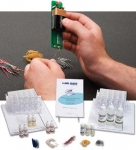| Introduction to Conductivity Experiment
SCIENTIFIC CONCEPTS / PROCESSES
- Explores electrical conductivity
- Develop principles of conductors and insulators
- Develop principles of electrolytes and non-electrolytes using acids, bases, salts, alcohols and hydrocarbons
- Test a variety of common materials for their conductivity characteristics
- Differentiate between strong, weak and non-conductors of electricity
All materials can be classified as a conductor, insulator or semi-conductor. Materials are classified according to their resistance to the flow of current. A conductor is a substance that is capable of carrying an electric charge from one point to another. An insulator blocks the flow of current. Semi-conductors are neither. Their conductivity lies in-between the two.
In Part 1 of this interesting Lab-Aid, students test several common objects to determine if they are conductors or insulators. In Part II, the students test electrical conductivity in aqueous solutions. They test an acid, base, salt, alcohol and a hydrocarbon.
This kit is an excellent introduction for students in physical science, general science and introductory chemistry courses.
Conductivity Indicators are required for these activities, but are not included with this kit. We recommend the Lab-Aids Conductivity Indicator. This kit is packaged complete for 30 students.
Contents List
- 1 Teachers Guide with MSDS
- 30 Student Worksheets and Guides
- 15 Chemplates with measuring and mixing spatulas
- 1 string, cut, pkg
- 1 paper clips, metal, pkg
- 1 pics, plastic, pkg
- 1 rubber bands, pkg
- 1 insulation copper wire, strips, pkg
Bottles:
- 2 Hydrochloric acid, 6M, 1/4 oz
- 2 Denatured alcohol, 1/4 oz
- 2 Glacial acetic acid, 1/4 oz
- 3 Deionized water, 2 oz.
Vials:
- 1 Calcium hydroxide
- 1 Sodium chloride crystals
- 1 Sucrose crystals, solid
|
 Introduction to Conductivity Experiment
Introduction to Conductivity Experiment Introduction to Conductivity Experiment
Introduction to Conductivity Experiment